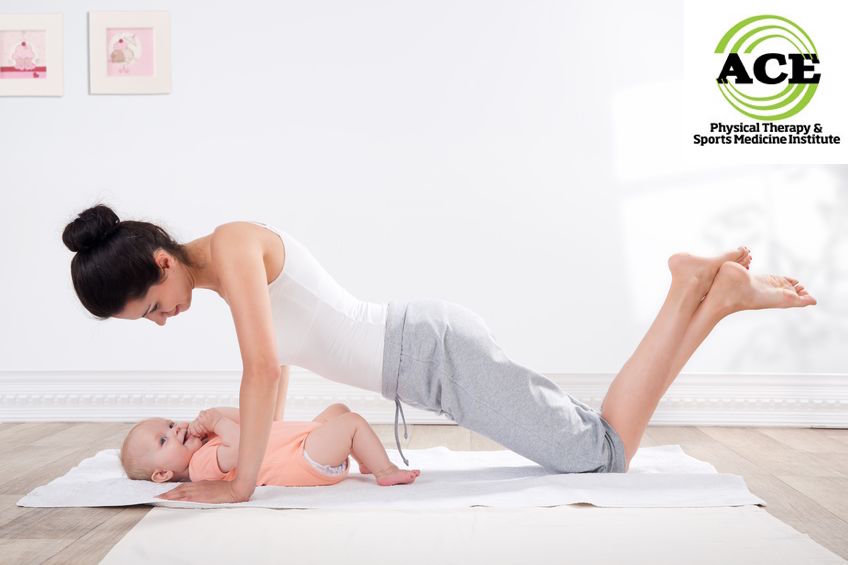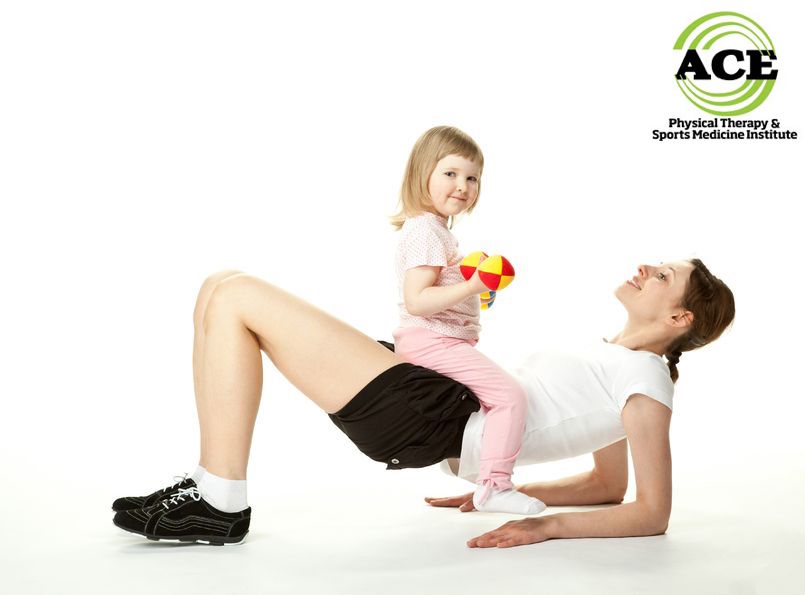EXERCISE FOR NEW MOMS WITH BABIES
Exercise for New Moms With Babies
by ACE Physical Therapy and Sports Medicine Institute
Tid Bits of Info.
- Exercise can help to stimulate endorphins, which are the body’s natural high.
- Losing the “baby weight” will be much easier if you eat well and exercise on a regular basis.
- Exercise will not affect your ability to breastfeed.
- It is natural to bleed following the birth of your baby, but it should not be heavy.
- If you sustain an injury or have symptoms of PFD, seek the advice and treatment of a Physical Therapist.
How can a New Mom find time to exercise? Caring for the newborn, balancing the demands of home, work, family and other life events can be overwhelming. The temptation is to put fitness on hold for an extended season that can range from months and even to years. Regular exercise can actually give you more energy, release stress, and help your body recover from the extended season of deconditioning. Exercise for new moms with babies can easily happen when you are together.*
Exercise for new moms should start slowly, and they never push themselves to a point that might harm the baby or themselves. They will have to rest for several weeks following the delivery process and their doctor will determine when they are able to begin. The routine should be designed to restore strength and cardiovascular fitness that was lost during the pregnancy and delivery process. The doctor will determine the proper time to begin the exercise routine based on the type of delivery (vaginal vs C-section), level of fitness before delivery and previous exercise experience of the new mom. The safety of the baby is the most important thing that the new mom must consider.
Almost from day one, you will be encouraged to begin a walking program. The distance and speed will be monitored and increased as the postpartum time period increases. The addition of pushing the stroller will enhance the cardiovascular program’s difficulty. Then strength training exercises will help to restore the natural strength that was lost due to the pregnancy and delivery process. Loss of strength can make you more susceptible to sustaining an injury when handling your child. Lifting the baby constantly throughout the day can put a new mom at risk of injury. Wrists, shoulders and low backs are the most commonly injured areas. A good strength-training program can help to prevent the injuries, but many new moms complain that they do not have the time to perform the exercise routine.
The best solution to this problem is to perform the strength training exercises with the baby at your side. You can use the baby as “weight or resistance” so the muscles will be exposed to an “over-load” and will begin to get stronger. The baby will not add much resistance or weight in the beginning but as you get further away from delivery date and the doctor oks the progression of exercise routine, the baby will begin to add more weight and resistance. You’ll most likely welcome the gradual climb in resistance.
There are several exercises that will be advantageous for the new mom to perform almost immediately, but with the doctor’s approval. The following are several exercises that can be performed throughout the first year of the baby’s life. It may take you that long to regain pre-pregnancy exercise capabilities remembering that it took almost 10 months to carry the baby to full term.
Squat: While the baby is in the carrier, the new mom should stand in front of a chair as if she is going to sit down. Her feet should be shoulder width apart. She should begin to “sit” down slowly and barely touch her buttocks to the chair seat. Return to an erect/standing position and repeat
Lunge with a Twist: Put your baby back into his or her carrier (facing you or facing away from you) and lunge forward keeping the front knee at a 90- degree angle. Twist to one side slightly, and then reverse the twist. Repeat the exercise and twisting using each leg as the front leg.
Planks: Lie your baby on their back so you are “face to face”. Push up off the floor and support your body weight on your forearms, elbows and toes. No other body part should touch the floor during the exercise. If it is too hard to support your body weight this way, you may allow your knees to touch the floor. The position should be held for 5-30 seconds or longer. You can do this exercise with straight arms, also
Bridge: Hold your baby on your lap or put them in the carrier. The closer the baby is to your waist the better (harder) the exercise is for you. Lie on your back (supine) and bend your knees, so your feet are flat on the floor. Contract your stomach muscles and try to move your belly button towards the floor. Slowly raise your buttocks off of the floor. Pause for 2 seconds at the top and be as still/stable as possible
Bicep Curls with Wrist Tilt: There are many versions of the Bicep Curl exercise and it can be performed while standing or sitting with or without the elbow held stationary against body. Hold the baby firmly under their arms with both hands. Your thumbs should be on the baby’s chest. Begin to bend your elbows and move your baby upward towards your face. When your baby is near your face, tilt them towards you and give them a kiss. Your thumbs should tilt towards your face. Slowly lower your baby to the starting position and repeat
Dips: Put your baby in the carrier facing you or facing away from you. Place your hands on a secure chair or couch with your fingers facing forward. Your legs should be stretched out in front of you. Your feet will determine how difficult the exercise will be on your arms. If your feet are far away from the chair the exercise will be extremely difficult on your arms. Keep your feet close by to begin and gradually move them away as you get stronger
If you get injured or begin to experience pain somewhere, seek out the advice and treatment of a Physical Therapist. They are able to treat all musculoskeletal injuries and you do not have to visit your doctor first. Also, if you experience symptoms of pelvic floor weakness (i.e. pain, incontinence) you should consult with a Physical Therapist that specializes in Pelvic Floor Dysfunction (PFD). These specialists can treat your symptoms and teach you how to perform certain exercises that will help the pelvic floor musculature function properly.
Exercising with your baby makes it a lot easier to budget the time that is needed for the routine. The “baby time” is good for both mom and baby. If you are diligent, you can make great strides in your overall fitness within a few months. Undoing ten months of gradual deconditioning will take some time. Go slow and steady and you will happy with the results.
* Each new mom and new baby are unique and may have particular challenges. The suggestions in this blog are for general reference and should be considered in light of specific directions from your healthcare provider.
Read more articles on our main website blog at: ACE-pt.org/blog
Vist our main website at www.ACE-pt.org


